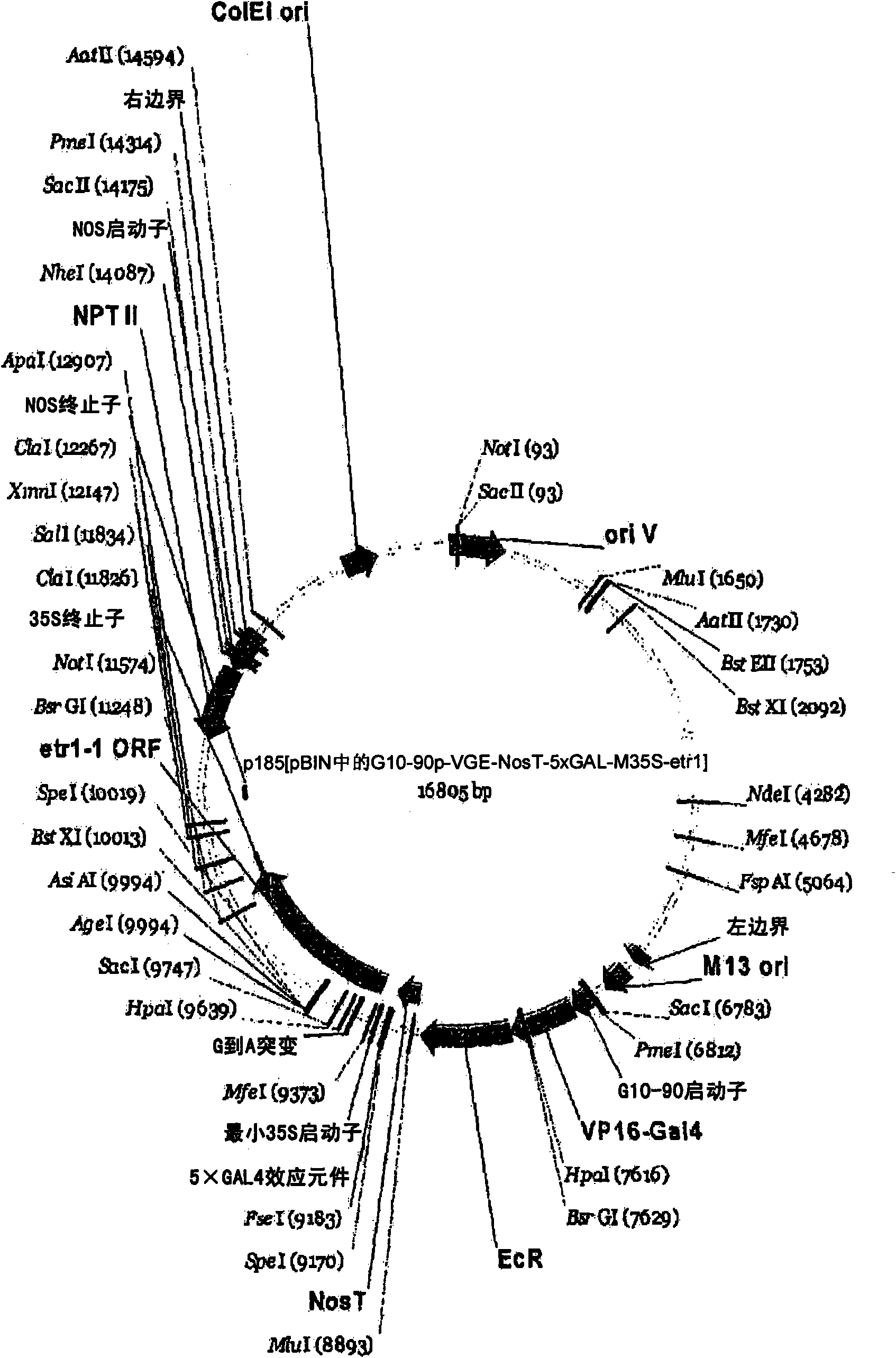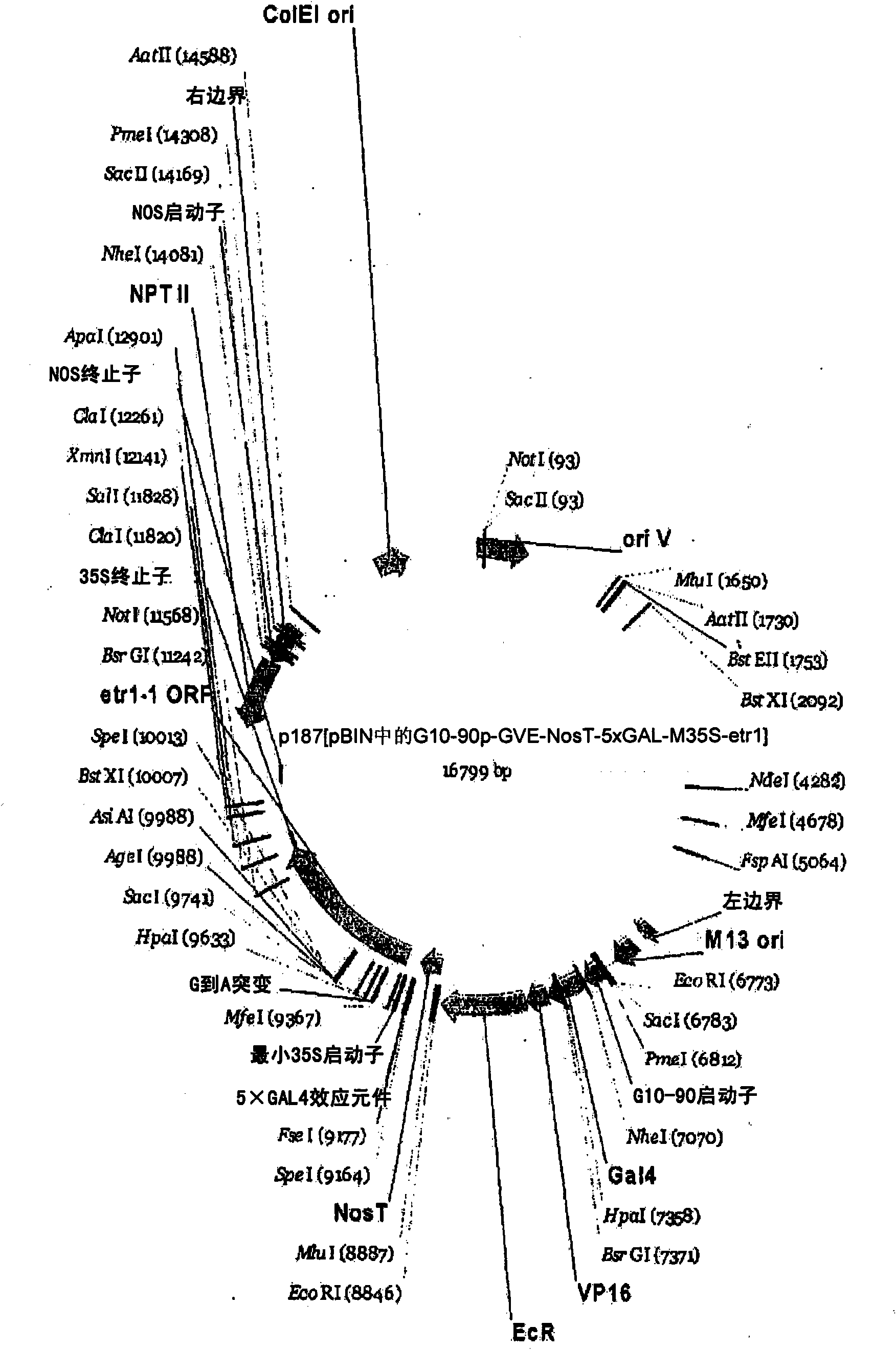Compositions and methods for the modification of physiological responses in plants
一种组合物、植物的技术,应用在生物化学设备和方法、植物细胞、重组DNA技术等方向,能够解决“关闭”基因表达的能力慢、诱导水平低、植物非毒性诱导剂特异性不够等问题
- Summary
- Abstract
- Description
- Claims
- Application Information
AI Technical Summary
Problems solved by technology
Method used
Image
Examples
Embodiment 1
[0104] Example 1: Plasmids
[0105] Gene cassette components include an activation cassette comprising: G10-90 constitutive promoter (nucleotides 1-243 of SEQ ID NO: 1), VP16 activation domain (nucleotides 249-529 of SEQ ID NO: 1) , the GAL4 DNA binding domain (nucleotides 534-983 of SEQ ID NO: 1), binds to the T52V mutant ecdysone receptor ligand bound to the NOS terminator sequence (nucleotides 2070-2364 of SEQ ID NO: 1) domain (nucleotides 990-1997 of SEQ ID NO: 1), which were cloned separately. Similarly, the target cassette assembly was cloned separately, and the target cassette included: 5 copies of the GAL4 response element (nucleotides 2391-2492 of SEQ ID NO: 1) and the minimal 35S promoter (nucleotides 2391-2492 of SEQ ID NO: 1 2499-2554), and the mutant etr1-1 gene (nucleotides 2557-4764 of SEQ ID NO: 1) and the 35S terminator sequence (nucleotides 4791-5001 of SEQ ID NO: 1 ). SEQ ID NO: 1 is shown in FIG. 4 .
[0106] These components are in SK - Expression cas...
Embodiment 2
[0128] Embodiment 2: Preparation of transgenic tobacco plants
[0129] Tobacco plants were transformed with the plasmid of Example 1, prepared by standard Agrobacterium-mediated leaf disc transformation as described in Fisher and Guiltinan 1995, Plant Molecular Biology Reporter 13:278-289. Plants were propagated on rooting medium containing kanamycin, and then the introduction and inheritance of the gene expression system was verified by PCR, as described below.
[0130] One leaf from each plant maintained in a magenta box was collected, snap-frozen in liquid nitrogen and stored at -80°C. The leaves (50-100 mg) were then transferred to KONTES tubes and ground using a drill with a KONTES disposable grinding rod for about 1 minute, followed by addition of lysis buffer for a few seconds. DNA was purified using the DNEASY Mini Kit (Qiagen) protocol. DNA was finally eluted in 100 μl.
[0131] Specific PCR primers were designed to amplify 529bp of VGE, 495bp of GVE, 463bp of mark...
Embodiment 3
[0138] Example 3: Effect of Regulating Ethylene Sensitivity on Tobacco Plant Growth
[0139] A triple reaction assay modified from Guzman and Ecker 1990 The Plant Cell, 2: 513-523 was performed to determine the role of modulation of ethylene sensitivity in the transformed tobacco plants of Example 2. Two leaves were obtained from each transformed plant designated 185-1, 184-3, 185-8, 185-11, 187-7, 187-13, 187-17 and 187-21 and cut into small pieces. These patches were plated on MSS plates containing 100 ng / L kanamycin with or without 10 μM of the inducer, 3,5-dimethyl-benzoic acid N-(1-ethyl-2, 2-Dimethyl-propyl)-N'-(3S-hydroxymethyl-5-methyl-2,3-dihydro-benzo[1,4]dioxine-6-carbonyl) Hydrazine. MSS plates without antibiotics or inducers were used as controls.
[0140] These plated plant tissues were grown at 25°C with light in the growth chamber to induce germination. The shoots were transferred to fresh plates and incubated for about 2 weeks at 25°C for continued growth....
PUM
 Login to View More
Login to View More Abstract
Description
Claims
Application Information
 Login to View More
Login to View More - R&D
- Intellectual Property
- Life Sciences
- Materials
- Tech Scout
- Unparalleled Data Quality
- Higher Quality Content
- 60% Fewer Hallucinations
Browse by: Latest US Patents, China's latest patents, Technical Efficacy Thesaurus, Application Domain, Technology Topic, Popular Technical Reports.
© 2025 PatSnap. All rights reserved.Legal|Privacy policy|Modern Slavery Act Transparency Statement|Sitemap|About US| Contact US: help@patsnap.com



